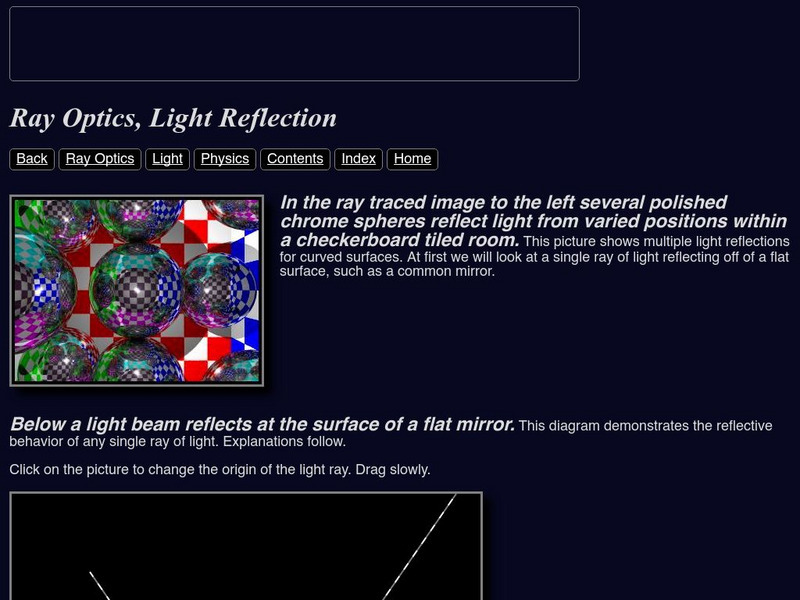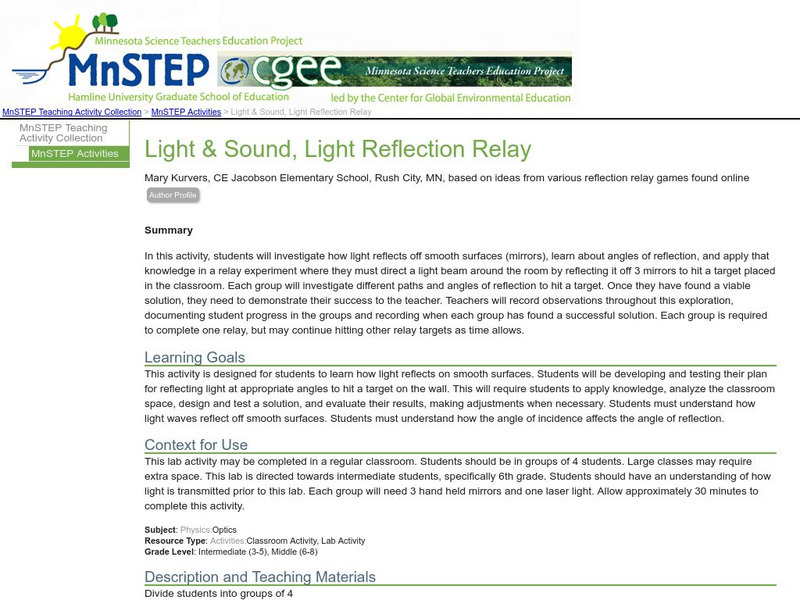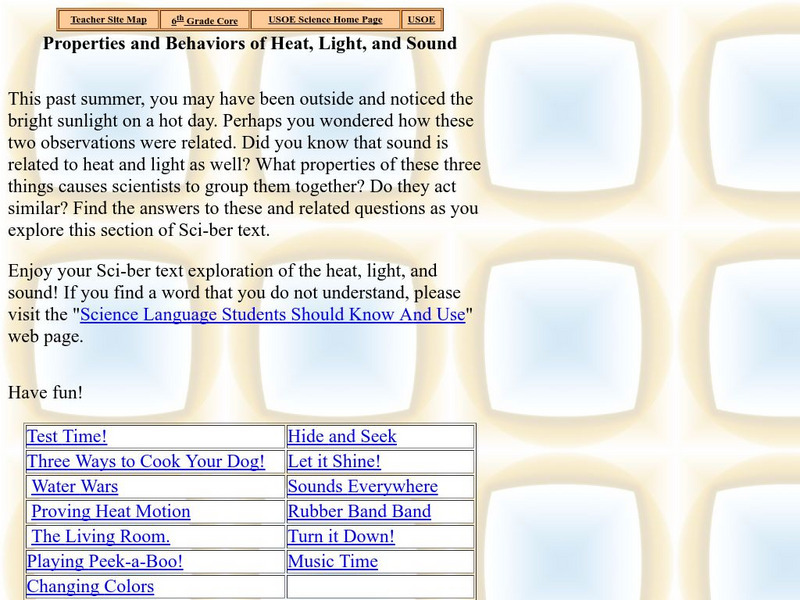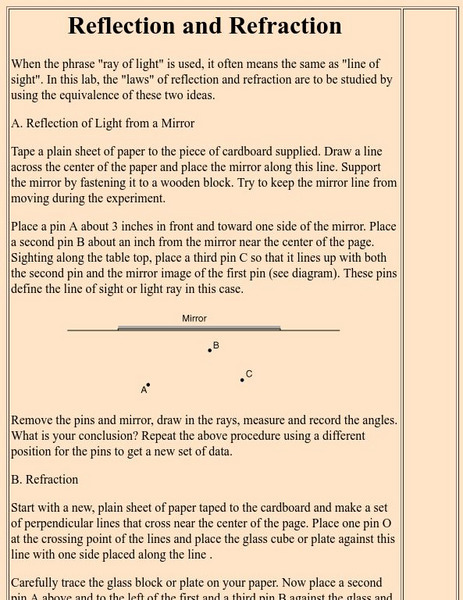Science Education Resource Center at Carleton College
Serc: Investigating Light Properties
Students will investigate how light travels and what it does when it hits an object. Light sources will be used to represent a beam of light. Students will direct the beam toward various objects and materials. Through observations...
Alabama Learning Exchange
Alex: How Light Travels
In this lesson, the students will be experimenting to show how light shines in a straight line. They will also be experimenting to see how light reflects using mirrors. The students will be working in cooperative learning groups to carry...
University of Texas at Austin
The University of Texas Mc Donald Observatory: Mirror, Mirror
In this activity, young scholars test the Law of Reflection based on experimental evidence. However, the back-silvered glass mirrors present a twist and offer them a challenge to work out what happened as the light traveled into and out...
Discovery Education
Discovery Education: Science of Everyday Life: Right Back at You! [Pdf]
What make a good reflective surface? For this lab, middle schoolers will investigate different surfaces with a reflectivity tester. Lesson plan includes information for students and teachers.
Curated OER
Ray Optics, Light Reflection
Site provides a diagram as well as a scientific explanation of light reflection. Includes links to ray optics, light and physics.
Science Education Resource Center at Carleton College
Serc: Light & Sound, Light Reflection Relay
In this exploration, students will investigate how light reflects off smooth surfaces, learn about angles of reflection, and apply that knowledge in a relay experiment.
University of Illinois
University of Illinois Urbana Champaign: Light and Optics
Rainbows and sunsets are called "atmospheric optics". They can be caused by light being absorbed, reflected, scattered, refracted, or diffracted by particles in the atmosphere. Learn all about different atmospheric optics along with...
CK-12 Foundation
Ck 12: Plix: Law of Reflection: Angle of Incidence
[Free Registration/Login Required] In the scenario shown here, the laser cannot shine through the black barrier but can hit all three targets by reflecting off of the floor. Use the red dot to change the angle of the laser generator and...
American Museum of Natural History
American Museum of Natural History: Ology: See the Light
Reflection, refraction, and the colors that make up white light is explored through lab activities after reading a brief background about light energy.
Utah State Office of Education
Utah Science: Properties and Behaviors of Heat, Light and Sound
How can scientists lump heat, light and sound together when investigating properties and behaviors? This learning module will address that question through a series of activities.
Physics Classroom
The Physics Classroom: Polarization
"How Do We Know Light Behaves as a Wave?" An answer is provided in this discussion of the polarization of light and the use of Polaroid filters in sunglasses. The four methods discussed on this page are: polarization by transmission,...
American Museum of Natural History
American Museum of Natural History: See the Light
Take a look at light with these three easy experiments
BBC
Bbc: Gcse Bitesize: General Properties of Waves
Light travels as waves. Waves can be described by their amplitude, wavelength and frequency. The speed of a wave can be calculated from its frequency and wavelength.
University of Minnesota
University of Minnesota: How Does Light Travel?
Contains a four step procedure to deriving the law of reflection using algebra, Fermat's principle, and calculus (simple derivatives). This is good for an in-class theoretical exercise.
My Science Site
Reflection Experiments [Pdf]
Looking for some hands-on activities to use with your students to teach reflection? This resource offers a couple of experiments on the angle of reflection and light absorption. This resource is in PDF form; requires Adobe Reader.
Synopsys
Synopsys: Optics for Kids: What Is Light?
An explanation of what light is and some of its properties.
Physics Classroom
The Physics Classroom: Reflection/ray Model of Light: Convex Mirror Images
Students explore three different ray diagrams for objects positioned at different locations along the principal axis in a convex mirror.
Physics Classroom
The Physics Classroom: Image Formation for Concave Mirrors Case A
This animation depicts the path of light to each person's eye. Different people are sighting in different directions; yet each person is sighting at the same image location. In this animation the image location is the intersection point...
Other
Denison University: Physics of Dance
The researchers in this study set up a mobile lab including six 3D cameras, three laptops, and 70 luminescent markers. Volunteer dancers were prepped with the markers before turning in front of the cameras, which flash infrared light to...
Georgia State University
Georgia State University: Hyper Physics: Reflection and Refraction
Reflection and refraction are explained with an experiment that uses a sheet of paper, cardboard, and other common materials.
My Science Site
Optics: Energy and Control [Pdf]
A very comprehensive unit including topics such as light and its source, visible sources of light, transparency of objects and much more. Also offers a resource list, blackline masters, and expectation list, expectation summary and a...
University of Maryland
Optics Highlights: Optics, Electromagnetic Waves, Quanta
Part of an anecdotal history on optics and the study of light. Extremely thorough treatment of the scientific evidence which led scientists to believe in the particle nature of light. Includes a short biographical sketch and discusses...
Utah Education Network
Uen: Enlightening Explorations
This lesson engages students in making observations about different features of light. Students will circulate in different light stations, reflect on what they have observed, and then write about what they learned.
Georgia State University
Georgia State University: Hyper Physics: Crossed Polarizers
At this univeristy physics department site, the polarization of light is explained and illustrated. Methods for analyzing light to determine the degree of polarization are stated and explained with equations.













